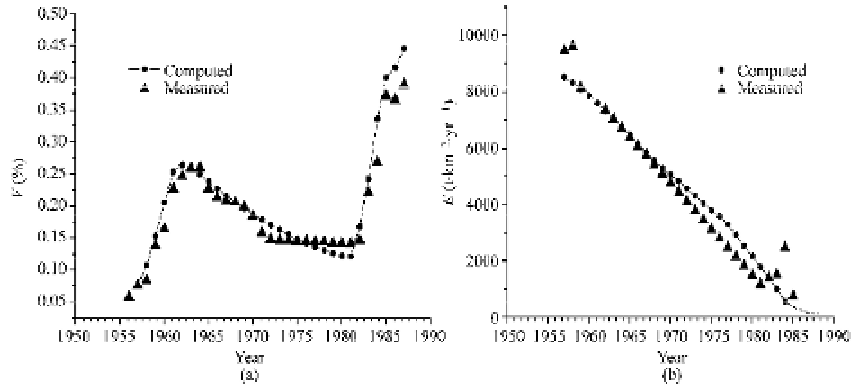Environmental Engineering Reference
In-Depth Information
motions and the rocks have been cut into small pieces. The area was covered with well-growing forest but
the forest cover was damaged due to copper mining and metallurgical industries over the past 400 years.
Erosion rates as high as 13,000 t/(km
2
·
yr) and debris flow occur very often in its 107 tributary gullies.
Because of soil erosion the vegetation cover deteriorated from more than 40% to less than 10% in the past
century. In the 1950s the vegetation cover was about 25% but deforestation and logging for the copper
and steel production in 1958 cut the vegetation by 5%. From that time the vegetation cover continued to
reduce due to the high rate of erosion. Since the late 1970s, however, people have made a great effort to
green the hills by reforestation but only limited results have been achieved. In the 1990s the reforestation
effort was intensified and the vegetation cover turned from reducing to increasing. The lead author of this
book has made field investigations in the area during the high erosion rate period in summer since 1998
and collected data on reforestation, land-use change, rate of erosion, and erosion control.
Fig. 2.33
(a) Computed and measured development process of vegetation cover (
V
) and (b) computed and measured
rate of erosion (
E
) for the Anjiagou watershed in China (Wang et al., 2003b)
The parameters
a
,
c
,
b
,and
f
were determined by applying a trial-and-error method for the Xiaojiang
watershed as follows:
a
= 0.03(1/yr),
c
= 0.000005(km
2
/yr),
b
= 0.054(1/yr),
f
= 200 (t/(km
2
·yr
2
)) (2.19)
The main ecological stresses on the vegetation are logging and reforestation. From the 1950s to 1970s
human activities exhibited minor influence on the vegetation and erosion, except for the intensive logging
reducing 5% of the forest cover in 1958. Since 1979 humans has reforested the hills at a rate of 1%
annually, and, in the meantime, humans has accelerated erosion, adding 60 t/(km
2
·
yr
2
) per year, due to
road construction, mining, and other activities. Such an impact is reinforced year by year. Thus, the
functions
Vt
W
()
and
Et
W
()
are:
Vt
( )
K
G
(1958)
'
V
(1979) e
nt t
(
)
½
0
¾
W
inst
W
0
(2.20)
nt t
(
)
Et
( )
'
E
(1979)e
0
¿
W
W
0
in which
K
inst
= 0.05 yr
-1
,
E
W
= 60 (t/(km
2
·
yr
2
)), and (1979' is the step
function with step at 1979. Substituting Eq. (2.20) into Eqs. (2.14) and (2.15) the following theoretical
solution is obtained:
V
W
= 0.01 yr
-1
,
n
= 0.1,
0
0
Vnd cE
(
)
mt
m t
W
W
nt t
(
)
Vt
( )
c
e
c
e
K
' '
(1958)
(1979)
(
e
nand f
(2.21a)
0
0
1
2
0
1
2
inst
)(
)


Search WWH ::

Custom Search